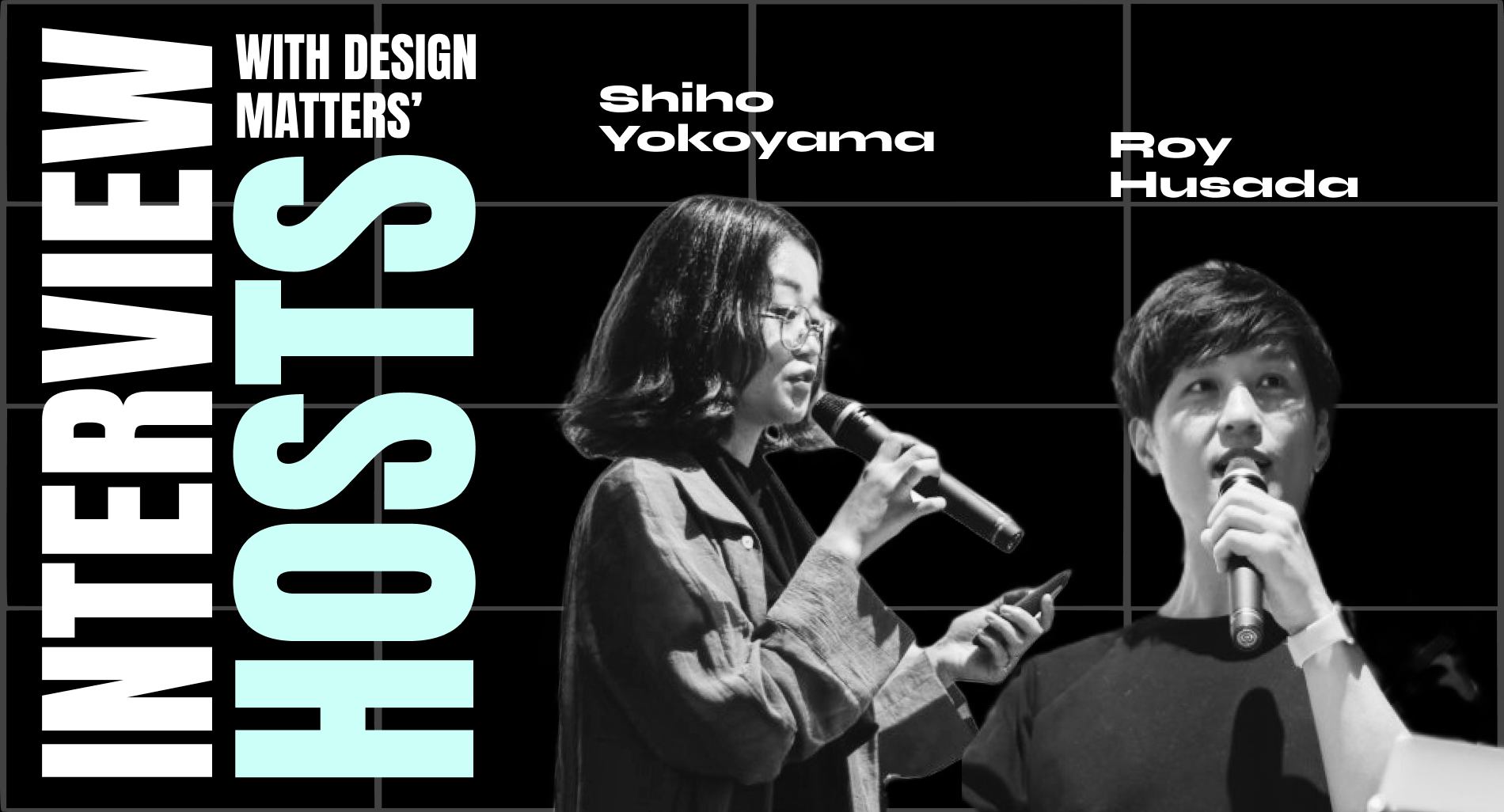As we celebrate the anniversary of Design Matters and the approaching of Design Matters Tokyo 24, it’s time to dive into the world of those who make design conferences happen from the stage. Let’s chat with this year’s Design Matters Tokyo hosts!
Design Matters Tokyo is returning for the 4th time on June 5-6, 2024, held in Tokyo and online. As always, the program features both Japanese and international talent. Don’t miss out on the chance to grab your ticket and hear more from Pleo, Yumemi, Jetbrains, Google Workspace, the Government of Japan, Smartbox assistive technologies and more! This year the conference will revolve around 3 themes: “Craftsmanship strikes back”, “Design, what’s next?” and “How to design a society?”. The themes explore the fusion of design and emerging trends in digital design as well as how design impacts society. They also touch upon how to bring non-designers into the design process and make it a more coherent process – read more here.
Shiho and Roy, who both spoke at Design Matters Tokyo in 2022, are now back as hosts. We asked them all about the digital design industry, what makes it stand out in Japan, and what it means for them to be a host of the conference.
Meet Shiho: Hi, I’m Shiho. I currently assist individuals and organizations ranging from big corporations to smaller art institutions with their UX, content, digital design, service design, and business creation. Additionally, I run our own wellbeing community. I currently live in a traditional Japanese house in Kamakura, Japan. It’s really a pretty area surrounded by beaches and small mountains. If you are attending the conference this year, I recommend you take a day trip there; it’s about an hour’s train ride from Tokyo.
I was a speaker at Design Matters Tokyo 2022, a workshop host in 2023, and I am thrilled to be back again this year as a conference host. Together with my co-host Roy, we are planning how to make DM audiences and speakers feel at home.
 Shiho giving a talk at Design Matters Tokyo 2022
Shiho giving a talk at Design Matters Tokyo 2022
Meet Roy: Ah, hello! I’m Roy, the founder behind RS—a studio where we innovate through brand localization and design, right here in Tokyo. Originally from Canada, I’ve always been drawn to how design intertwines with everyday life, often in little magical ways. Japan has been an inspirational teacher; its blend of tradition and modernity constantly influences my work and perspective. Hosting Design Matters Tokyo is pretty surreal—combining my love for engaging, sometimes weird conversations with my passion for design. It’s all about connecting, learning, and yes, occasionally fumbling over my words due to crippling social anxiety.
 Roy giving a talk at Design Matters Tokyo 2022
Roy giving a talk at Design Matters Tokyo 2022
How do you think Japanese culture has shaped the design industry and design around the world?
Shiho: In my opinion, one of the most globally recognized books about Japanese culture is Junichiro Tanizaki’s “In Praise of Shadows (陰翳礼讃).” First published in 1933, the book discusses the differences between Japanese and Western cultures. In Western culture, people strive to illuminate spaces brightly, eradicating all shadows. In contrast, the Japanese value shadows, leveraging them to create art that thrives within their embrace. Tanizaki argues that the distinctive beauty and aesthetics of traditional Japanese culture lie in discovering beauty within these shadows. This characteristic of ancient Japanese aesthetics manifests in various aspects, including Japanese architecture, lighting, and tableware.

I believe the reason why this book has garnered a global readership is because of its concept that offered a different perception in the Western design industry. Beauty does not solely reside in objects themselves. Beauty can be found in the subtle interplay of shadows between objects, in the interplay of light and darkness.
Roy: It’s incredible how much the world draws from Japan. When I speak with my clients, who often work at global companies, I explain that Japanese design exists on a fascinating spectrum. There’s Japanese design specifically for Japan, then there’s Japanese design tailored for the West, and something unique in between—a blend for those who navigate both worlds.
These mash-ups of ideas always bring a fresh perspective. For instance, Scandinavian design is consistently captivating, and the concept of “Japandi”—a beautiful blend of Japanese and Scandinavian aesthetics—is a perfect example. While it can’t be labeled strictly Japanese, it still embodies a unique presence that adds significant value to the global design landscape.
What aspect of Japanese design do you think is not understood or known enough in the rest of the world?
Shiho:I think Japan is good at designing things that can last. From car manufacturing to artisan products, I admire the durability of Japanese designs. What many people may not realize is that Japan is home to many of the world’s oldest companies.
According to the Data of Long-Lived Institutions, there are over 5,500 companies worldwide that are over 200 years old, with 3,100 of them based in Japan. That means more than half of the oldest companies are from Japan. I think that is because, the Japanese traditionally have been able to prioritize long-term success over immediate profit. It’s definitely not easy for a business to continuously provide value to customers and markets while maintaining a long-term commitment. In today’s world, where sustainable business and consumption practices are being questioned, Japan’s emphasis on long-term thinking becomes increasingly important.
Roy: A cool but often missed part of Japanese communication is how we use English words in unique ways. It’s called “Japlish” or “Wasei-eigo.” These words look and sound like English but mean something totally different here. Take “service,” for example. In English, it means help or assistance. But in Japan, “service” means something free, like a bonus item you get with a purchase. With many sites and restaurants with tablets with auto translations for multiple languages, it could cause confusion and also adds to why Japanese is such a difficult language to localize.

What do you think the Japanese design industry needs more (or less) of?
Shiho: Not just in the design industry but in contemporary Japan in general, there seems to be a widespread belief that “simplifying things” is inherently good, while “complicating things” is bad. The media look for a short answer, while in business, there’s a demand for quick solutions.
As a designer, I sometimes feel that I contribute to perpetuating this trend of advocating for simplification. While the ability to find order in chaos is undoubtedly a valuable skill for designers, we shouldn’t shy away from complexity. One of the themes for this year’s conference is “how to design a society?” When designing society, it’s essential to confront complexity, especially when facing people with diverse ideologies. Not everything can be neatly divided into black and white, such as political ideologies or religious beliefs. We should encourage a mindset that welcomes and navigates complexity effectively. By doing so, designers can avoid the trap of jumping to conclusions and create more nuanced and innovative solutions that address the diverse challenges of today’s world.
Roy: I believe Japan is burdened with the concept of avoiding ‘claimers’ or ‘kasuhara’. This can sometimes stifle the creativity of individuals and groups before they even begin. On the flip side, there’s also the risk of ignoring feedback altogether. Creativity should be more of a shared activity. It isn’t limited to people with ‘creative,’ ‘art,’ or ‘design’ in their titles. When you try to make everyone happy, you end up making no one happy.
What inspired you to become involved with Design Matters Tokyo?
Shiho: I still remember how supportive others were when I was a speaker in 2022. Giving a talk is a nerve-breaking thing, but the community was so encouraging. I hope to be the same for others this time around.
Roy: It was and still is a wonderful opportunity to share with and motivate other people at different stages of their design careers by providing guidance. I find increasingly that I enjoy being a part of and contributing to the community in any way I can.
 Roy giving a talk at Design Matters Tokyo 2022
Roy giving a talk at Design Matters Tokyo 2022
You have been part of Design Matters Tokyo before, but not as a host. How is Design Matters Tokyo different from other design events in Tokyo?
Shiho: I feel there has been an increase in design-related events in Japan, especially after the pandemic when more people are looking for personal connections. Design Matters Tokyo is still one of the few events that embrace local and global, niche and large-scale elements all in one setting. A speaker from a global mega-corporation speaking after an independent writer is what makes it interesting.
 Design Matters Tokyo 2023
Design Matters Tokyo 2023
Roy: Design Matters Tokyo stands out because it focuses on fostering genuine connections and deep discussions among designers. Unlike many other events that feel more like networking marathons, Design Matters Tokyo is all about sharing authentic stories and making long-lasting friendships. The intimate atmosphere for designers is one of the best!
What long term impact do you hope to see from designers attending Design Matters Tokyo?
Shiho: It will be great if attendees can meet someone new at the event. It could be a new friend, colleague, mentor, or anyone else. I believe meeting new faces can have a long-term impact on your career or life.
Roy: Building a supportive network is crucial. I hope attendees form lasting connections with other designers, creating a community where they can share ideas, collaborate, and support each other long after the event ends. Also, I want designers to remember that design is fun and we’re lucky to do it. Despite the industry’s challenges, many people wish they were in our shoes. So, enjoy the process, have fun, and be grateful for the opportunity to create.
 Design Matters Tokyo 2023
Design Matters Tokyo 2023
Why does design matter?
Shiho: Gosh, lately I don’t even know what design is anymore. What I do know, however, is that I enjoy the people who come with the term, and the conversations with those people are what matter the most.
Roy: Design walks the line between emotion and logic. It’s an amazing blend of art and science that has the power to transform our world. It solves problems, enhances experiences, and brings beauty and joy into everyday life. I feel like I’m part of the most incredible cult that can truly save the world.
Has your view on digital design changed since you became part of Design Matters? Are there any speakers or workshops you are particularly excited about?
Shiho: To be honest, I don’t know if my view on digital design has changed with Design Matters. What I do love about the talks at Design Matters is that people share their honest stories. I’m looking forward to hearing not just glamorous achievements but also authentic struggles this year.
Roy: I think it has highlighted the differences in how digital design is approached in Japan versus globally. There are so many inspirations both sides can learn from each other, which is really exciting.










